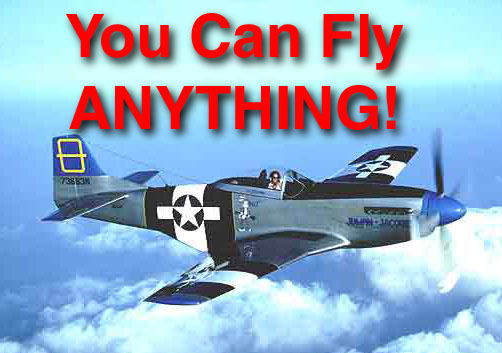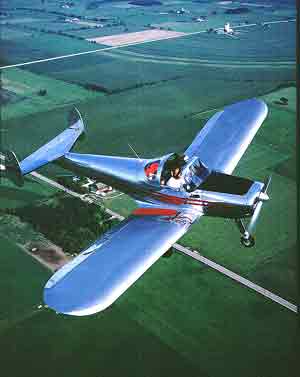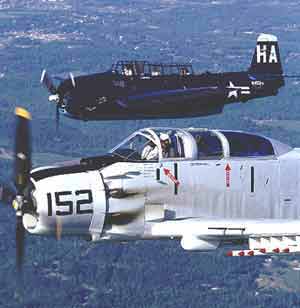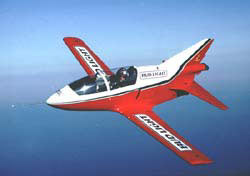
Text and Photos by: Budd Davisson
Sport Aviation

Text and Photos by: Budd Davisson
Sport Aviation
You want to know a closely guarded secret? Those folks you see flying Mustangs and Pitts Specials and all those other supposedly hard-to-fly airplanes aren’t any different than you and me. They are mere mortals. Maybe they have more money or they’ve been flying longer, but as far as basic skill goes, potentially you’re as good as they are. The only difference is they have invested the time and training to make sure their skill levels match the airplane in question. The bottom line is, and you don’t have to read the rest of this article to come to this conclusion, anyone can learn to fly any kind of airplane, if they have the desire to do so. Anyone!
You don’t believe that? Here’s an example that, in my 35 years as an instructor, is not even remotely extreme: Recently, I tried to get my insurance company to let me solo a student pilot, who had only 17 hours total time, in my two-hole Pitts Special just to show it could be done. He had nine hours of Cub time and eight hours with me in the Pitts and he was absolutely capable of flying that airplane. He was nothing exceptional as students go, other than having an above average desire to conquer the airplane. My insurance company, of course, replied, “ARE YOU OUT OF YOUR MIND? A 17 HOUR STUDENT IN A PITTS? NO WAY!” Or something like that. The Pitts, as with so many other airplanes, has an unearned reputation as a fiercesome airplane but this student could have handled it with absolutely no problem because all of his training pointed him in that direction.
Think about the young pilots early in WWII. Most of them went into combat in high powered airplanes with total flight times under 250 hours. Did those young pilots have serious problems? No, because even though it wasn’t an ideal situation, all of their training and flight time had been aimed at putting them in high performance airplanes.
The name of the game, obviously, is training, but at least as important as training (which we’ll return to later) is an unabashed willingness to rise to the challenge a given airplane represents. Let’s look at that statement again: “...a willingness to rise to the challenge...” What exactly does that mean?
 For one thing, a willingness to rise to the challenge means much more than simply having the intestinal fortitude to strap it on and go flying. Nerve is not part of the equation. In fact, one of the most dangerous traits a pilot can possess, when it comes to this particular subject, is being TOO eager to rise to the challenge. This is often an indication they don’t recognize the challenge in the first place. All airplanes are not created equal and, although in theory all pilots ARE created equal, at any given point in their development they may differ wildly. It is the wise pilot who, regardless of experience, approaches a new airplane with the wariness of a bronc buster circling his next mount. The smart pilot assumes the airplane can outsmart him and approaches the airplane accordingly. The pilot who assumes an airplane is just an airplane, is eventually going to get his tail twitched.
For one thing, a willingness to rise to the challenge means much more than simply having the intestinal fortitude to strap it on and go flying. Nerve is not part of the equation. In fact, one of the most dangerous traits a pilot can possess, when it comes to this particular subject, is being TOO eager to rise to the challenge. This is often an indication they don’t recognize the challenge in the first place. All airplanes are not created equal and, although in theory all pilots ARE created equal, at any given point in their development they may differ wildly. It is the wise pilot who, regardless of experience, approaches a new airplane with the wariness of a bronc buster circling his next mount. The smart pilot assumes the airplane can outsmart him and approaches the airplane accordingly. The pilot who assumes an airplane is just an airplane, is eventually going to get his tail twitched.
Okay, let’s assume you’re Mr. (or Ms.) Average Pilot, have 200 hours, fly 40 hours a year and want to strap on an airplane you’re certain is going to challenge your skill level. How do you approach it? Let’s make a concrete (and very real) example out of it: let’s say all of your time is in C-152’s and you want to buy a single-place, 180 hp Pitts (or Glasair III, etc.). Is this a bad idea? Not necessarily, but it could be. It depends very much on your mental attitude and your willingness to do what is necessary to come up to the level of the machine. It also assumes you recognize that the leap you’re about to take is just below that of preparing to fly the space shuttle. It is, however, a very doable task (it’s done all the time) but it’s going to require some dedication and commitment on your part to keep the safety factor high and the fright factor low.
In getting ready to fly something like a Pitts (or Glasair or Lancair, etc., etc.) the pure performance of the airplane is a factor for a low time pilot. Coupled with that is the totally different handling characteristics and the possibility of getting behind the airplane. A majority of pilots haven’t flown airplanes which have high acceleration on takeoff, the ability to climb at 1500-2000 fpm and have a high power-off sink rate. A lot of instructors joke that 100 hours of C-152 time is the same hour repeated 100 times, which is not entirely the case, but, when compared to high-perf birds, or something like a golden age antique, the comment is close enough. The 152 (or most other trainers, for that matter) will only challenge your skill to a certain level and your brain is accustom to that level of challenge. One of the major feats to be accomplished in your transition training is to speed up or alter your thought processes to match the airplane in question. All of the Ginseng or vitamin E in the world isn’t going to help. The only way to get your brain working faster or in different directions is to repeatedly expose it to fast moving or new situations until it takes the hint and begins accelerating.
 Any long time instructor in something like a Pitts can count on one thing being consistent in the first hour with a new, low time student: the pure rapidity with which the approach happens (35-45 seconds from power cut to touch down) causes the student’s brain to fog over. They are simply overwhelmed. In the case of something like a WACO cabin job or Pietenpol, they have similar, although possibly not as severe, problems. Every instructor approaches this kind of situation differently, but one technique that helps during that first hour is to shoot approaches right into ground effect and barely kiss the ground while initiating a go around. There is no attempt to make any landings and the speed barely decays so the go-around is easy and instantaneous. That way the student can concentrate on the approach because he’s not distracted by the fear of having to make the landing. Also more approaches can be made in an hour and, in the act of going around, he or she learns exactly where the ground lies. At the end of that first hour, their brain is starting to spool up, but they’re still struggling mentally to stay with the airplane, if it’s a high speed bird. At that point, some students may think they aren’t up to the task. If you feel that way, make a promise to yourself to fly one more hour. In almost every situation by the end of that hour, the lights will be coming on. By hour three, you’ll be saying, “Hey, I can learn to do this. It may not be pretty, but I can do it!” As a student, don’t let apparent lack of progress during the early phases of your training or a feeling of being overwhelmed depress you or dissuade you from your goal. Just remember, this isn’t magic. If one guy can do it, so can you.
Any long time instructor in something like a Pitts can count on one thing being consistent in the first hour with a new, low time student: the pure rapidity with which the approach happens (35-45 seconds from power cut to touch down) causes the student’s brain to fog over. They are simply overwhelmed. In the case of something like a WACO cabin job or Pietenpol, they have similar, although possibly not as severe, problems. Every instructor approaches this kind of situation differently, but one technique that helps during that first hour is to shoot approaches right into ground effect and barely kiss the ground while initiating a go around. There is no attempt to make any landings and the speed barely decays so the go-around is easy and instantaneous. That way the student can concentrate on the approach because he’s not distracted by the fear of having to make the landing. Also more approaches can be made in an hour and, in the act of going around, he or she learns exactly where the ground lies. At the end of that first hour, their brain is starting to spool up, but they’re still struggling mentally to stay with the airplane, if it’s a high speed bird. At that point, some students may think they aren’t up to the task. If you feel that way, make a promise to yourself to fly one more hour. In almost every situation by the end of that hour, the lights will be coming on. By hour three, you’ll be saying, “Hey, I can learn to do this. It may not be pretty, but I can do it!” As a student, don’t let apparent lack of progress during the early phases of your training or a feeling of being overwhelmed depress you or dissuade you from your goal. Just remember, this isn’t magic. If one guy can do it, so can you.
Making the leap into a high performance bird, especially a taildragger like the Pitts, requires some transitional training to make life easier for both you and the instructor. Yes, you can go from scratch in something like a Pitts or Glasair, but why put you and your instructor through all that aggravation and expense when there’s an easier solution. In the case of going from a 152 to a high-perf taildragger, some dual time leading to a tailwheel endorsement in something like a Citabria will get your brain moving and you’ll learn the basics of the tailwheel in a much more benign (read that as less exciting) environment. If going into a Pitts or Skybolt or something similar, log a few hours of landings in the back seat of the Citabria to get used to the world disappearing as you flair. The lack of visibility is some times as big a problem as the totally strange, fast moving environment the new airplane represents.
 If you’re making the jump from 152/172 into Glasair III, or something similar, buy some retract time from a flight school. A few hours in a Mooney or Bonanza will put you on the right path and will keep you from getting spooked by the Glasair and its peer group. Make some higher speed, no-flap landings to get a feel for the environment. Also, don’t forget that, if it’s a two-place homebuilt you are transitioning into, if you can find the right instructor (more on that later), it is now legal take instruction in your homebuilt.
If you’re making the jump from 152/172 into Glasair III, or something similar, buy some retract time from a flight school. A few hours in a Mooney or Bonanza will put you on the right path and will keep you from getting spooked by the Glasair and its peer group. Make some higher speed, no-flap landings to get a feel for the environment. Also, don’t forget that, if it’s a two-place homebuilt you are transitioning into, if you can find the right instructor (more on that later), it is now legal take instruction in your homebuilt.
It’s not unusual for a pilot who has either skipped the check-out and/or training and made his way through the first few hours in his new airplane by sheer guts and luck to develop a debilitating fear of the machine. After a short time, they start finding reasons not to go to the airport. It is too windy. Too cloudy. The engine doesn’t sound right, etc., . This is why so many homebuilts wind up for sale in the first 50 hours of their lives. The builder didn’t give adequate thought to whether he was ready to rise to the challenge or not before he started the project, and, once he got the airplane flying found he didn’t like the dry taste in his mouth. In so many of these cases, the apprehension started out as the result of an inadequate training period before flying the new airplane. Even if the desire to meet the challenge is there, if the lack of training results in a number of flight hours in which the pilot is definitely not enjoying himself (translated as, scared silly), then the airplane is going to be sold. A surprisingly small percentage of those pilots, once they find they are having problems, will seek instructional help. It’s really hard to overcome apprehension, once it has set in.
The obvious question has to be, where do you find the kind of training you need, when the airplane is something other than a middle of the road, general aviation airplane? For the more popular homebuilts, the kit manufacturer can usually hook you into someone who specializes in that airplane. For classics, a number of flight schools around the country still use them for training. In most of these cases, you may have to travel a distance to get to the right instructor, but that’s part of the commitment and it’s worth the investment.
 With the new ability for an instructor to give instruction in the exact airplane to be flown, even if it’s certified as a homebuilt, checking out became much easier. Still, there is the problem of finding a CFI who is familiar enough with the airplane in question to do a thorough and safe job of checking you out. Just because he’s a CFI doesn’t mean he knows anything about Glasairs or RV’s, WACO’s, Stearmans, etc. .
With the new ability for an instructor to give instruction in the exact airplane to be flown, even if it’s certified as a homebuilt, checking out became much easier. Still, there is the problem of finding a CFI who is familiar enough with the airplane in question to do a thorough and safe job of checking you out. Just because he’s a CFI doesn’t mean he knows anything about Glasairs or RV’s, WACO’s, Stearmans, etc. .
Often you’ll have to settle for a substitute trainer; a trainer that is close in characteristics to the airplane you want to fly, but isn’t that airplane. Training for a single place airplane, like the Pitts we mentioned, you can use the two hole version, but the instructor has to be able to explain the differences. As far as that goes, a two-hole Pitts is good for just about all high performance tailwheel birds although it is overkill for most of them. A Lancair or Glasair owner might be able to use a Mooney or Bonanza with the flaps up. Look around and find what has similar characteristics, although the choice is often limited by what is available.
Something has to be said about making too big of a jump: if you are a low time pilot with the urge and money to jump into super high performance aircraft and/or warbird, our advice is to go slow. At any experience level, training can teach you when to push the levers and pull the knobs but you can’t be given that unquantifiable quality that comes from simply being in and around airplanes for a long time. It’s usually called “experience”, but what it represents is a reserve of knowledge which you can fall back on when a situation begins to fall apart. If you barely have a hold of the skills required to fly a given airplane, you’ll be fine until something goes wrong or the environment decides to test you. Part of rising to the challenge of an airplane is realizing it is wise to overcompensate with training. If the leap looks too big, pick an airplane that’s somewhere in the middle and build some experience flying that before making the big jump.
In the final analysis, it is your attitude towards learning that will determine how well you will do in learning your new airplane. Just know that regardless of your flight background, you can fly any airplane in the world given enough of the right kind of training. It is up to you to seek that training out.